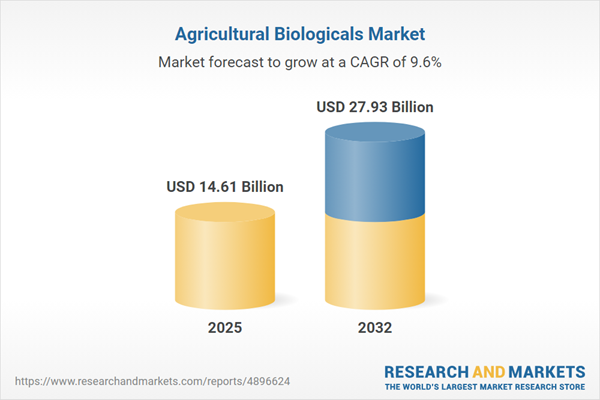Speak directly to the analyst to clarify any post sales queries you may have.
The Agricultural Biologicals Market is rapidly evolving as new technologies, regulatory changes, and shifting demands transform global agriculture. Senior executives are reevaluating biological inputs as a pathway to increased productivity, enhanced sustainability, and differentiated market positioning in a dynamic regulatory and trade environment.
Market Snapshot: Agricultural Biologicals Market Growth and Trends
The Agricultural Biologicals Market grew from USD 13.39 billion in 2024 to USD 14.61 billion in 2025. It is expected to continue expanding at a CAGR of 9.62%, reaching USD 27.93 billion by 2032.
This growth reflects industry-wide momentum for bio-based crop solutions, regulatory support, and increased investment in sustainable farming strategies globally. Market advances are driven by new product development, accelerated adoption across key agricultural economies, and technology-led solutions addressing soil health and resilience.Scope & Segmentation: Comprehensive Coverage Across Biologicals and Use Cases
- Product Categories: Biofertilizers (Nitrogen-Fixing, Phosphate-Solubilizing, Potash-Mobilizing), Biopesticides (Biofungicides, Bioherbicides, Bioinsecticides), Biostimulants (Amino Acid-Based, Humic Acid-Based, Seaweed Extract-Based)
- Mode of Application: Foliar Spray, Seed Treatment, Soil Treatment
- Source Type: Biochemical, Bacteria, Fungi, Viruses
- Formulation Type: Dry Granules, Powder, Liquid
- Crop Types: Cereals & Grains (Maize, Rice, Wheat), Commercial Crops (Coffee, Cotton, Sugarcane), Fruits & Vegetables (Berries, Citrus, Onions, Potatoes, Tomatoes), Oilseeds & Pulses (Groundnut, Soybean, Sunflower), Turf & Ornamentals
- Functional Roles: Crop Protection, Plant Growth Enhancement, Soil Health Improvement, Stress Resistance
- End Users: Agricultural Cooperatives, Farmers, Research Institutes
- Distribution Channels: Offline, Online
- Regions Covered: Americas (United States, Canada, Mexico, Brazil, Argentina, Chile, Colombia, Peru), Europe (including United Kingdom, Germany, France, Russia, Italy, Spain, Netherlands, Sweden, Poland, Switzerland), Middle East (UAE, Saudi Arabia, Qatar, Turkey, Israel), Africa (South Africa, Nigeria, Egypt, Kenya), Asia-Pacific (China, India, Japan, Australia, South Korea, Indonesia, Thailand, Malaysia, Singapore, Taiwan)
- Key Companies: American Vanguard, Andermatt Biocontrol, Arysta Lifescience, BASF, Bayer, Biobest, Bioceres Crop Solutions, Bioworks, Certis USA, Corteva, FMC, Isagro, JH Biotech, Koppert, Novozymes, Nutrien, Stockton Group, Sumitomo Chemical, SYMBORG, Syngenta, T. Stanes & Company, Terramera, UPL
Key Takeaways for Senior Decision-Makers
- Biological products are moving from experimental use to central roles in commercial crop management, influenced by regulatory shifts and consumer demand for reduced chemical inputs.
- Leading firms collaborate with biotech innovators and invest in advanced formulation technologies to accelerate new solutions that address variable field conditions and crop-specific needs.
- Digital agriculture integration, including predictive analytics and remote sensing, supports targeted product application, improves return on investment, and facilitates real-time performance feedback to growers.
- Market competition is driving consolidation, with established agrochemical and seed companies acquiring or partnering with biological specialists to expand offering portfolios and increase distribution reach.
- Regional strategies adapt to local agronomic and regulatory environments, with high growth seen in North America, Latin America, and Asia-Pacific regions through research-driven deployment and tailored outreach initiatives.
- The sector’s evolution is accelerating supply chain localization, especially in response to trade policy adjustments and tariffs, influencing sourcing, logistics, and manufacturing decisions.
Tariff Impact: Navigating 2025 U.S. Tariffs on Agricultural Biologicals
The 2025 United States tariff measures on imported agricultural biologicals are altering trade flows and input costs for industry participants. Importers are revising procurement channels, shifting sourcing toward lower-tariff zones or local manufacturers. This changing landscape compels stakeholders to reevaluate supply chain strategies, form joint ventures for local production, and collaborate on regional innovation to mitigate disruption and sustain market competitiveness.
Methodology & Data Sources: Rigorous Market Research Processes
This report is underpinned by a blended research approach, including in-depth interviews with industry leaders, regulatory experts, and agronomists, as well as analysis of peer-reviewed publications, patents, and government sources. The multi-stage methodology ensures accuracy and actionable insights by integrating primary perspectives and cross-verifying secondary data.
Why This Report Matters: Actionable Intelligence for Stakeholders
- Enables executives to anticipate regulatory and trade-driven changes impacting sourcing, pricing, and go-to-market strategies in the agricultural biologicals market.
- Supports investment and R&D decisions with detailed segmentation, regional growth trends, technology adoption patterns, and company innovation strategies.
- Equips supply chain and commercial leaders with clarity on evolving end user requirements, product performance differentiation, and collaborative opportunities.
Conclusion
As agricultural biologicals become integral to sustainable farming, stakeholders must deploy adaptive strategies to capture growth while managing risk in a changing regulatory, technological, and trade context. This report offers senior decision-makers the insight required for effective, forward-facing planning in the global agricultural biologicals market.
Additional Product Information:
- Purchase of this report includes 1 year online access with quarterly updates.
- This report can be updated on request. Please contact our Customer Experience team using the Ask a Question widget on our website.
Table of Contents
3. Executive Summary
4. Market Overview
7. Cumulative Impact of Artificial Intelligence 2025
Companies Mentioned
The companies profiled in this Agricultural Biologicals market report include:- American Vanguard Corporation
- Andermatt Biocontrol AG
- Arysta Lifescience Corporation
- BASF SE
- Bayer AG
- Biobest Group NV
- Bioceres Crop Solutions
- Bioworks, Inc.
- Certis USA L.L.C.
- Corteva, Inc.
- FMC Corporation
- Isagro S.p.A. by Crop Demetra Limited
- JH Biotech, Inc.
- Koppert B.V.
- Novozymes A/S
- Nutrien Ltd.
- Stockton Group
- Sumitomo Chemical Co., Ltd.
- SYMBORG CORPORATE, SL
- Syngenta AG
- T. Stanes & Company Limited
- Terramera, Inc.
- UPL Limited
Table Information
| Report Attribute | Details |
|---|---|
| No. of Pages | 183 |
| Published | November 2025 |
| Forecast Period | 2025 - 2032 |
| Estimated Market Value ( USD | $ 14.61 Billion |
| Forecasted Market Value ( USD | $ 27.93 Billion |
| Compound Annual Growth Rate | 9.6% |
| Regions Covered | Global |
| No. of Companies Mentioned | 24 |









